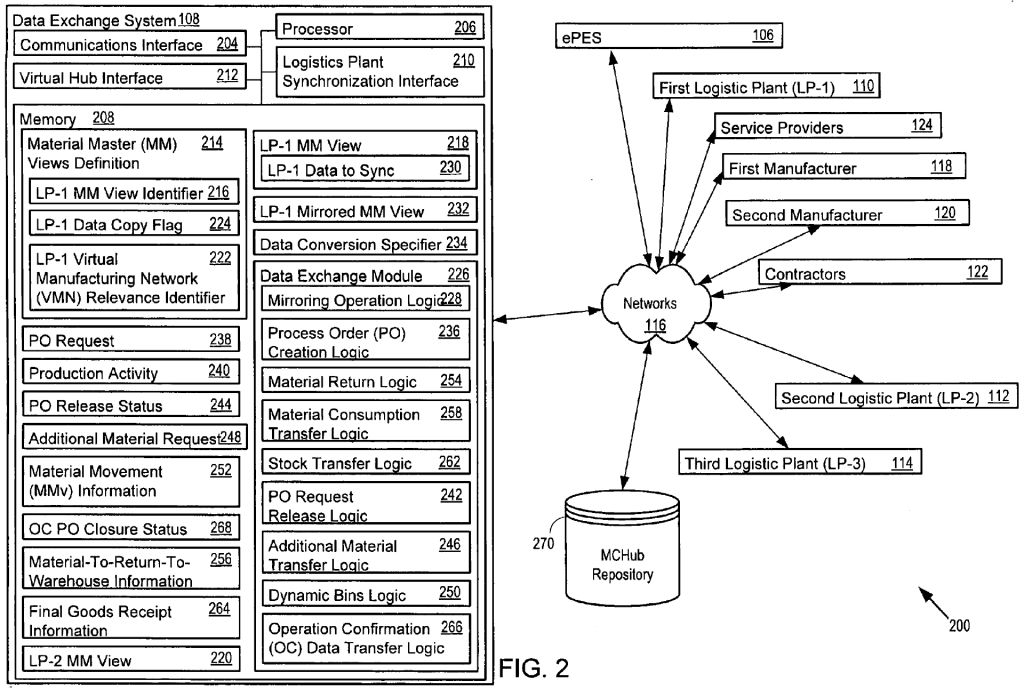This decision concerns a data exchange system in the area of logistics. However, none of the effects produced by said system were considered technical by the EPO. Here are the practical takeaways from the decision T 2522/16 () of March 25, 2021 of Technical Board of Appeal 3.4.03:
Key takeaways
The invention
The subject-matter of the European patent application underlying the present decision was summarized by the Board in charge as follows:
2. The application
The application is directed at a virtual manufacturing network (VMN). The manufacturing processes of multiple geographically separated logistics plants are to be controlled and monitored (paragraph [30] of the published application), for instance in view of stringent regulation associated with pharmaceutical and processed food products (paragraphs [1] and [2] of the published application). For example, the application aims at improving and identifying alternatives to the cumbersome manual processes employed to compile batch records during production (paragraph [3] of the published application).
The ultimate aim of the invention is an improved business administration process, in particular involving rules and regulations for pharmaceutical products (see further paragraphs [4] to [6] of the published application).
For this purpose, information selected according to predefined criteria is kept consistent across different logistics plants. Data selected according to predefined criteria is copied, in a distributed or networked computer system, between local computers and a central computer, these computers being connected to each other through interfaces.

Fig. 2 of EP 2 199 960 A1
Here is how the invention was defined in claim 1:
-
Claim 1 (main request - labeling f1, f2 ... added by the Board)
A data exchange system (108) comprising:
f1 a logistics plant synchronization interface (210) operable to connect to multiple logistics plants (110, 112, 114);
f2 a virtual hub interface (212) operable to connect to a centralized manufacturing collaboration hub (104) that implements a virtual manufacturing network for the multiple logistics plants (110, 112, 114); and
f3 a memory (208) comprising:
a material master views definition (214) specifying a material master view identifier (216) for a logistics plant material master view (218, 220), a virtual manufacturing network relevance identifier (222) for the material master view identifier (216), and a logistic plant data copy flag (224) for the material master view identifier (216), wherein the material master views definition (214) is shared with the multiple logistics plants (110, 112, 114) for facilitating a mirroring operation (228);
f4 a data exchange module (226) operable to:
analyze the virtual manufacturing network relevance identifier (222) to determine whether the logistics plant material master view (218, 220) is relevant; and when the logistics plant material master view (218, 220) is relevant, analyze the logistic plant data copy flag (224) to determine when to initiate the mirroring operation (228), the mirroring operation (228) comprising synchronization of data in the logistics plant material master view (218, 220) and received through the logistics plant synchronization interface (210) from an originating logistics plant from among the multiple logistics plants (110, 112, 114), with a mirrored material master view (232) for the logistics plant material master view (218, 220) in the virtual manufacturing network through the virtual hub interface (212); and
f5 a data conversion specifier (234) operable to direct the data exchange module (226) to implement a specified data conversion during the mirroring operation (228), wherein the conversion is performed according to rules defined in the data exchange module (226); and
f6 a processor (206) operable to execute the data exchange module (226).
Is it patentable?
Against the rejection of the first instance examining division, the appellant argued as follows:
Care should be taken when distinguishing between non-technical and technical features according to the Comvik approach as set out in T 0641/00, in line with the Case Law of the Boards of Appeal.
For instance, for a feature to be technical, it was sufficient that it was based on technical considerations, as discussed in T 0769/92. Although this decision dated from before the Comvik decision, it had not been invalidated in the Enlarged Board of Appeal's opinion G 03/08. Instead, it had been endorsed by the Enlarged Board of Appeal in its recent decision G 01/19 under point 126 and thus still applied.
An application to the present case would result in recognizing that, while the content of the rules defined in the claims reflected business needs, their implementation by means of the data structure defined in feature f3, including technical aspects like a "copy flag", was based on technical considerations.
In more detail, the appellant was of the opinion that the the subject-matter of claim 1 provides a technical effect and solves a technical problem:
... Instead, the subject-matter of claim 1 of the main request, directed to a data exchange system and further defined by features f1 to f6, achieved the effects of
i) ensuring data integrity in the sense of data consistency across different locations in a networked information system as defined in features f1 and f2 in real time,
ii) facilitating centralized control of logistics plants by the data structure and its functionalities defined in feature f3 and illustrated in Table 7 and paragraphs [75] and [76] of the published application,
iii) improving data exchange to other logistics plants by mirroring and converting relevant data according to features f4 and f5.
Effects i) to iii) were technical and the corresponding features of claim 1 of the main request had thus to be taken into account for assessing inventive step.
In view of technical effects i), ii) and iii) the objective technical problem to be solved by the skilled person starting from a networked information system could then be formulated as
– how to enable an efficient data exchange with improved data integrity within a heterogeneous networked information system.
However, the Board in charge takes a different position and considered none of these effects technical:
3.2.1 Effect i), data consistency
A process for achieving consistency of manufacturing information across different locations does per se not solve a technical problem, but merely fulfills a business administration aim.
...
3.3 Effect ii), centralized control
The centralized control of plants mentioned in the application (see paragraph [30]) does not relate to any technical industrial control system at production process level in the form of, e. g., a supervisory control and data acquisition (SCADA) system or a distributed control system (DCS). ...
Such a centralized specification is, however, a necessary part of the administrative process to achieve the business administration aim of keeping certain manufacturing information consistent.
...
3.4 Effect iii), efficient data exchange by mirroring and converting relevant data
The "data conversion specifier" referred to in feature f5 relates to specifying which data are to be converted upon synchronization, or, in the words of the description, when being "copied" (see Table 8). The conversion may be as basic as leaving the data unchanged or transforming it to a blank data entry in accordance with the administrative needs. The "data conversion specifier" has therefore a similar functionality as the "material master views definition" and hence represents, like the latter, pure business matter.
Against this background, the Board in charge concluded as follows:
3.5 Conclusion concerning technical effects / closest state of the art
In line with the Case Law of the Boards of Appeal mentioned by the appellant, it follows from the above that the technical aspects of effects i) to iii) referred to by the appellant do not go beyond commonly known effects arising whenever a conventional networked information system is used to receive, store, process and send data. The Board is not aware of any other technical effects provided by the features of claim 1 of the main request, either.
A conventional networked information systems as generally known at the filing date of the present application may therefore be regarded as representing the closest state of the art, in line with point 2.6 of the contested decision.
...
3.6 Inventive step
The subject-matter of claim 1 of the main request differs from such a conventional networked information system only by aspects relating to an administrative information exchange process which do not provide a technical effect, as set out by the Examining Division (see points 2.3.1 to 2.3.10 of the Reasons).
Since the distinguishing aspects represent pure business matter, they can be included in a non-technical requirement specification given to the technically skilled person in line with what was set out in T 1463/11 (see point 13 of the Reasons).
Thus, it is not appropriate to formulate the objective technical problem as suggested by the appellant. Instead, the objective technical problem can be formulated as how to implement the administrative information exchange process as defined by the Examining Division in points 2.3.1 to 2.3.10 of the Reasons of the contested decision on a generally known conventional networked information system.
Such an implementation would have been a straightforward task for the technically skilled person.
Hence, the Board arrived at the result that the subject-matter as claimed lacks inventive step and thus dismissed the appeal.
More information
You can read the whole decision here: T 2522/16 () of March 25, 2021
The content of this article is intended to provide a general guide to the subject matter. Specialist advice should be sought about your specific circumstances.

